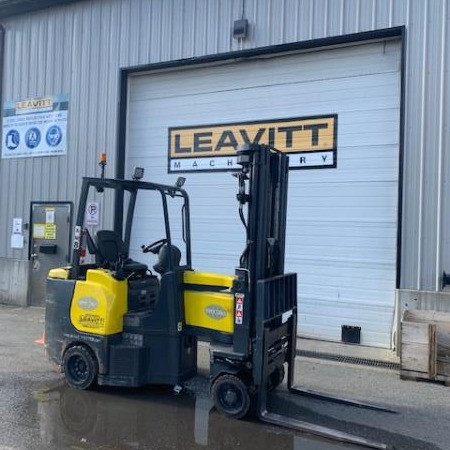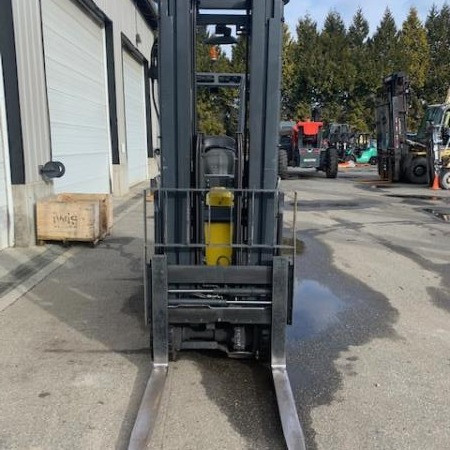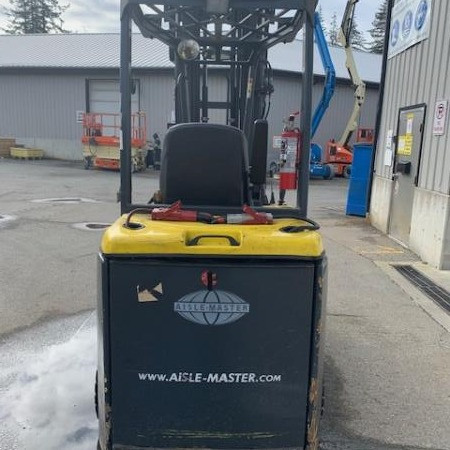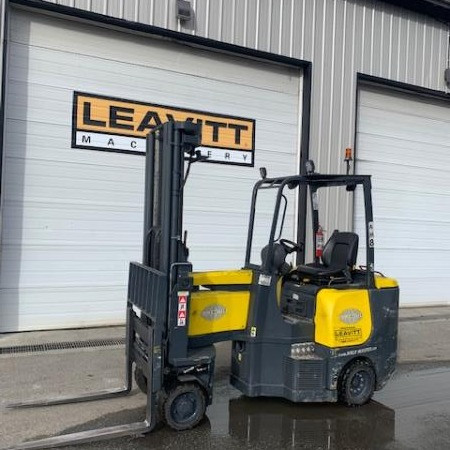Very Narrow Aisle Forklift Santa Clara
Used Very Narrow Aisle Forklift Santa Clara - Warehousing solutions often focus on layout and space saving solutions in order to cut down on costly square footage and decrease travel time required to transport goods throughout the warehouse and loading dock areas. Extremely narrow aisles offer more storage space since there is less space needed for aisle access. Warehouse optimization consists of warehouse configurations.
Warehouse Optimization
There are several significant benefits of implementing very narrow aisle warehouse optimization.
Because very narrow forklift trucks were developed to take up less space in maneuvering, it is now possible to decrease warehouse aisle width to less than half the width required by standard forklifts. Numerous narrow aisle forklifts deliver better stacking heights to increase the storage capacity on a square foot basis. This means that costs are decreased because less warehouse space is necessary for the same amount of stock than if a standard aisle configuration were used. Square footage is costly in urban areas and any way to reduce warehousing costs can save a company money. When planned carefully and properly, it is possible to increase warehouse storage area by up to 80 percent by implementing a very narrow aisle width configuration. Very narrow aisle design facilitates greater product access and more rack faces. This usually equates to less travel time gathering and storing product as more product is located within a smaller, more accessible area.
Warehouse layouts usually utilize a narrow aisle or very narrow aisle plan. Less than eleven feet of aisle width is needed by narrow aisles. Very narrow aisles usually use an aisle width of approximately 6.5 feet across. Storage options are greatly increased with these aisle width options. Using a forklift for order picking and stocking can be difficult in these aisle widths, especially when turning. These challenges are met by using very narrow forklifts to gain access and complete tasks.
Before choosing a forklift for a particular job, it is vital to know the dimensions of the aisle. It is important to have the correct aisle dimensions before forklift shopping to avoid securing a machine that won’t fit its’ intended location. Finally, it is critical that any utilities, posts or columns are taken into account before settling on a specific narrow aisle forklift design as these may affect access to aisles by some forklifts or prevent warehouse optimization.
Very Narrow Aisle Forklift Trucks
Very narrow aisle forklift trucks are almost always powered electrically, usually by rechargeable battery. These very narrow aisle trucks are more commonly available as stand-up riders, which helps increase productivity and operator comfort. The most popular kinds of very narrow aisle forklift trucks include turret or swing-mast, end-control riders, order pickers and reach trucks.
Reach Forklift Trucks
Developed as a kind of rider stacker forklift, the reach forklift trucks can be configured for narrow aisle locations. It got its name by its function of reaching its forks forward to get to a load. The moving mast and the moving carriage are two types of reach trucks. The moving carriage functions by lowering and raising the carriage and the operator. The moving mast works by raising and lowering the forks along the mast, while the operator stays at ground level. Of the two kinds of reach trucks, the moving mast reach truck is the safer of the two varieties. Reach trucks use a pantograph system, a type of jointed framework, which allows the operator to reach for or place a load without the need to move the forklift itself.
Order Pickers
Order pickers have been created to pick items from difficult, high racking systems. Order pickers are specific for lighter stock items that can be lifted by hand. These order pickers work by lifting the operator up to the level of goods in order to identify and pick the specific item or items necessary to fill an order.
End-Control Riders
End-control riders are used to pick loads located at floor level and transport the load horizontally, rather than lift or lower loads from various heights.
Turret or Swing-Mast Forklift
The turret or swing mast very narrow aisle forklifts have a swivel mast that pivots and articulates. The mast swivels to enable pallets to be positioned on the right or left side of the forklift.
Guided Very Narrow Aisle Trucks
Many very narrow aisle forklift trucks are able to be guided down aisles by wire or rail.
Because the forklift is guided, thereby reducing the possibility of the forklift bumping racks while moving down the aisle, the aisles can be extremely narrow. In rail-guided models, sets of rails are placed into the floor on each side of the aisle. They run the length of the aisle and also curve around the aisles’ edge. The forklift is fitted with special wheel guides that slide into the rails, preventing the forklift from moving outside the rail guards.
Wire-guidance forklift systems install wires on the floor instead of rails and the wires run down the middle of the aisle. These wire-guides work along the same principle as the rail guards except that the narrow aisle forklift is fitted with a wire-guide system that allows it to communicate with the floor wires which effectively steer the forklift, preventing it from straying outside of an allotted range.
Work Site Considerations
There are a few critical considerations when implementing a very narrow aisle configuration. Because these very narrow aisle configurations include very tall racking systems, the condition of the floor and the construction of the racks must be done properly in order to avoid potentially disastrous outcomes. There are four main locations that need to be ideally prepared before any racking system can be installed. These areas need to be monitored continuously including fixing cracks in the floor, ensuring the racks are straight, a level floor and an appropriate load capacity of the floor.
Level Floor
Because of the height of the racking systems, any slight slope of the floor is likely to negatively affect the plumbness of the racks, especially over time when loads are continuously placed and removed on the racks. A level floor is vital for the safety and integrity of the operator, employees, stock and the warehouse.
Crack Repair
When cracks in the floor are spotted, they should be assessed and, when necessary, repaired immediately. Safety can become compromised when flooring cracks become 3/8 inches wide. They require proper filling with a substance that is as hard as the floor.
Floor Load Capacity
The floor needs to meet specific minimum requirements prior to a narrow aisle configuration. At a minimum, the floor should consist of 3,000 psi concrete as well as contain evenly distributed rebar approximately 3 to 4 inches below the surface. Depending on the load requirements and configuration, additional reinforcements may be needed.
Plumb Racks
Of great importance is the proper installation of the racking system. Rack failure can happen if they are improperly installed. One of the most important details to ensure proper installation, is that all racks are plumb. If necessary, rack shims should be used to ensure the racks are plumb within 1 inch at the 30 foot height of the racks.
If the above measures are not taken or are improperly implemented, it is likely to cause a racking failure. Employees can become hurt or killed in the event that racking failure occurs. Goods can be damaged along with forklifts and other equipment. These measurements are vital to the success of installing a safe and productive narrow aisle configuration.
Very Narrow Aisle Forklift PDF
Stock Number: 207213 GL
Make: AISLEMASTER
Model: 44E
Year: 2013
| Stock Number |
207213 GL |
| Make |
AISLEMASTER |
| Model |
44E |
| Year |
2013 |
| Category |
Very Narrow Aisle Forklift |
Stock Number: 209213 GL
Make: AISLEMASTER
Model: 44SE
Year: 2015
| Stock Number |
209213 GL |
| Make |
AISLEMASTER |
| Model |
44SE |
| Year |
2015 |
| Category |
Very Narrow Aisle Forklift |
Stock Number: 208758 GL
Make: AISLEMASTER
Model: 44SE
Year: 2015
| Stock Number |
208758 GL |
| Make |
AISLEMASTER |
| Model |
44SE |
| Year |
2015 |
| Category |
Very Narrow Aisle Forklift |













